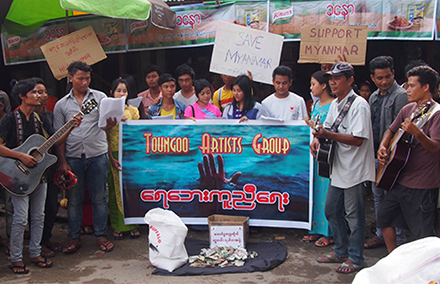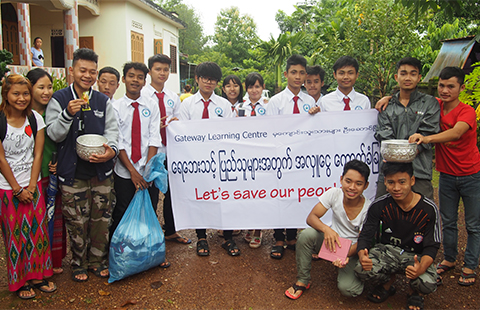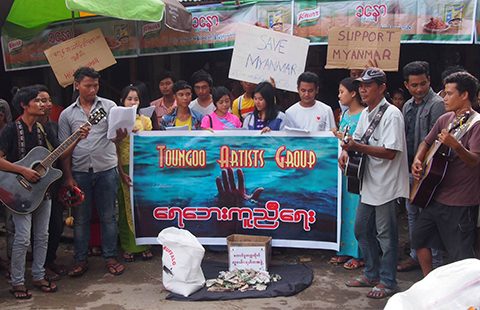
Artists perform to raise funds for victims of Myanmar’s floods. Photo supplied.
How ordinary citizens stepped into the breach and responded to the nation’s worst disaster since Cyclone Nargis.
A shirtless farmer trudges up to a semi-circle of singing volunteers. Without a word, he offs his military-issue motorbike helmet and pulls a 1000 kyat (US$ 1) note from the inner-rim, placing it gently on the loungyi (a wrap that often replaces trousers) laid out on the ground in front of a printed vinyl sign: “Taungoo Artists Group – Flood Victims Appeal”.
He nods at the guitarist and shuffles back to the crowd, gathered to listen intently to songs honouring the victims of the flood written by local musicians and poets.
Meanwhile, nine hours southeast a group of 15 students from an English language centre walk through the heavy rain in a small ethnic Karen, Buddhist town outside Karen State’s capital, Hpa-an. They hold a banner urging local residents to come out and donate to support Myanmar’s flood victims, although no insistence is needed.
Despite the fact that three groups have already come before them requesting donations, people willingly hand over 1000 kyat bills, clothes, bags of rice and other supplies. They encourage the students to maintain their energy and enthusiasm in the rain, offering crates of soft drink, hot tea and sweet snacks.
Trucks and cars driving past on the road to Thailand stop to hand cash out the window, into silver Buddhist bowls (palar), the ubiquitous symbol of Myanmar’s vibrant volunteer and fundraising culture.
While the heavy rains of the monsoon season are often a godsend for local farmers after the preceding months of scorching heat, this year they have wreaked havoc across the country, claiming lives, submerging villages, schools and fields, creating a national crisis unseen since the devastation of Cyclone Nargis in 2008.
Facing perhaps the worst flooding in a generation, and a response which the Myanmar government has itself labelled as ‘weak’, local religious and welfare groups, students and artists have taken the lead in raising and redistributing hundreds of thousands of dollars worth of rice, noodles, water, clothes and medical supplies for communities in need.
Areas in half of the country are now flooded, four states are considered disaster zones and over 100 people have been confirmed dead. While Myanmar’s state-focused, regime-led transition has garnered most of the headlines in recent years, this latest crisis reveals the centrality of non-state welfare actors and reciprocity practices that have long characterised the livelihoods strategies of millions across the country.
It has also seen the mobilisation of a national consciousness and sense of obligation for fellow citizens that is animating both volunteers and donors alike.
Appeals in bustling Yangon have dominated pages in local newspapers and broadcasts across social media and news-sharing sites. In particular, the work of famous businessmen, singers and actors have attracted many headlines. However, the sense of crisis and commitment to the ‘Save Myanmar’ campaign is deeply felt across the entire country.
In Taungoo in central-east Myanmar, university students and local welfare groups are leading appeals through markets, singing songs emphasising their shared kinship with the victims of floods. “We are family, like brothers and sisters”, one song implores. “For many, family life is broken into pieces; for those who are hungry and looking for peace, whose hope is destroyed, let’s give them help”.
Where the average wage is less than US$ 4 a day, teachers, trishaw riders and fruit-sellers rush to offer a few dollars of assistance to victims. “We all live in the same country”, says a 19- year-old university student who coordinated a fundraising group. He was moved to action after seeing photos of a student in Chin State weeping over her drenched schoolbooks on Facebook. “They are suffering from the flood, whilst we are not”, he says. “We have to give them help.”
In Hpa-an, where there are over 1500 displaced by the flooding Thanlwin River, some efforts of these groups are more locally orientated. The vast bulk are directed north to people outside kin, ethnic and friendship networks. Here, where life has for so long been defined by division and the 60- year conflict between the government and insurgents, the needs of people from greater Myanmar are now at the forefront of everyone’s minds.
More than four teams have sprung up, raising tens of thousands of US dollars. One group came together over Facebook, made up of members of the pro-democracy 88 Generation Group, local teachers, and entrepreneurs – “united”, they say, by their passion “to help the people”. Gathering strength as they took to the streets and as their online presence grew, one young Buddhist teacher remarked that they were lucky to have Baptist Karen church members in their group. “They have the best voices, and draw a lot of attention”, she explained.
Indeed, the fundraising has seen different religious groups join hand- in- hand to raise assistance for flooded areas. Rice merchants of all faiths from Taungoo and surrounding towns have donated over 100 large sacks of rice worth around US$ 30 each. In Hpa-an a Muslim donation group gathered friends and business colleagues to donate to the flood victims located at the local monastery.
Meanwhile, local Baptist churches in both Hpa-an and Taungoo have been collecting funds and holding prayer sessions for flood victims.

Youth collect donations for Myanmar’s flood victims. Photo supplied.
The crisis has exposed the centrality of monasteries, monks and religious institutions as the first port of call for communities in need. In Hpa-an, one monastery took in more than 1000 individuals, many of whom are ethnic Bamar migrant workers with limited local support. The local Muslim mosque nearby in the marketplace also welcomed families in need, providing them with food, water and other supplies.
Nurses from the Hpa-an public hospital were also stationed at each of these sites to provide medical checks and other assistance where needed. One monastery in an effected village outside Hinthadar in the Irrawaddy Delta visited by a Taungoo welfare group distributing aid had even become an impromptu workshop for local mat makers whose houses were flooded.
Motivating much of this aid are widely-held Buddhist beliefs in the value of compassionate social action. Implicit in this is an emphasis on direct relationship between giver and receiver, and a general uneasiness about intermediaries – central concerns for groups taking the lead in fundraising around the floods.
The vast bulk of donations are used to purchase goods such as rice or bottled water at local markets that are then delivered directly to the effected communities by volunteers. A student leader in Hpa-an explained the need for such in-kind donations. “You can’t just give people money directly, you don’t know what they would spend it on.”
The preference for direct relationships has only strengthened after images of muddied sacks of rice delivered by the military surfaced on Facebook, and rumours of township authorities creating ‘unnecessary bottlenecks’ in the delivery of aid spread.
All these circuits of national solidarity and direct social assistance buzz with the perceived failure of the government to respond adequately as an institution of redistribution and protection. “We are like fatherless children!”, proclaimed one Taungoo volunteer in a speech about the slow response of the government. “That’s why, as family, we need to help each other”.
After the catastrophically inadequate state response following the devastation of Cyclone Nargis, in which more than 138,000 people died, the government has now invited international assistance for flooded communities, a rare acknowledgement of state failure.
As government aid as well as assistance from regional neighbours and Western powers including Australia, the US and Europe begin to trickle into flooded communities, it is being dwarfed by help from hundreds of local welfare groups criss-crossing the nation in trucks to support victims.
Coordinating relief from these teams with more formal and longer-term systems of assistance and recovery in communities where many have lost their homes and this season’s paddy yields, not to mention loved ones, is likely to be a major challenge.
What is evident in the crisis is the tide of national solidarity among everyday people throughout Myanmar. It is the sign of a deep resilience that relies more on fellow citizens and welfare groups than on a government, which for many is seen as distant and largely absent in times of tragedy and need.
Justine Chambers and Gerard McCarthy are PhD scholars from the ANU Coral Bell School of Asia Pacific Affairs currently undertaking fieldwork in Myanmar.
This article was also published in The Myanmar Times.
 Facebook
Facebook  Twitter
Twitter  Soundcloud
Soundcloud  Youtube
Youtube  Rss
Rss 